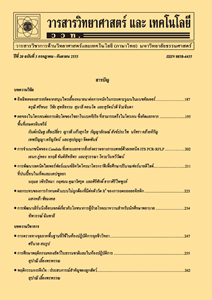การเปรียบเทียบประสิทธิภาพของแผนภูมิควบคุมสำหรับจำนวนรอยตำหนิ
Main Article Content
Abstract
บทคัดย่อ
งานวิจัยนี้มีวัตถุประสงค์เพื่อเปรียบเทียบประสิทธิภาพของแผนภูมิควบคุมสำหรับจำนวนรอยตำหนิ 4 ชนิด เมื่อค่าเฉลี่ยของกระบวนการมีการเปลี่ยนแปลงไป ได้แก่ แผนภูมิควบคุมผลรวมสะสม (Poisson CUSUM) แผนภูมิควบคุมค่าเฉลี่ยเคลื่อนที่ถ่วงน้ำหนักแบบเอกซ์โพเนนเชียล (Poisson EWMA) แผนภูมิควบคุมค่าเฉลี่ยเคลื่อนที่ถ่วงน้ำหนักแบบเอกซ์โพเนนเชียลสองครั้ง (Poisson DEWMA) และแผนภูมิควบคุมค่าเฉลี่ยเคลื่อนที่สองครั้ง (Poisson DMA) เมื่อข้อมูลมีการแจกแจงแบบปัวซง โดยปัจจัยที่นำมาศึกษา คือ ความยาววิ่งเฉลี่ยเมื่อกระบวนการอยู่ในการควบคุม () เท่ากับ 500 จำนวนรอยตำหนิโดยเฉลี่ย () เมื่อกระบวนการอยู่ในการควบคุม มีค่าตั้งแต่ 1, 3, 5, 7, 9, 10, 15 และ 20 จำนวนกลุ่มย่อย () เท่ากับ 100 และขนาดการเปลี่ยนแปลงค่าเฉลี่ยของกระบวนการ () เท่ากับ 0.01, 0.03, 0.05, 0.07, 0.09, 0.10, 0.30, 0.50, 0.70 และ 0.90 ซึ่งเกณฑ์ที่ใช้วัดประสิทธิภาพของแผนภูมิควบคุม คือ ค่าความยาววิ่งเฉลี่ยเมื่อกระบวนการอยู่นอกเหนือการควบคุม () โดยจำลองข้อมูลภายใต้สถานการณ์ต่าง ๆ ด้วยวิธีมอนติคาร์โล และทำซ้ำในแต่ละสถานการณ์จำนวน 1,000 รอบ ผลการศึกษาพบว่ากรณี สำหรับทุกค่า แผนภูมิ Poisson CUSUM มีประสิทธิภาพดีที่สุด รองลงมาคือแผนภูมิ Poisson DEWMA และแผนภูมิ Poisson EWMA ซึ่งมีแนวโน้มให้ประสิทธิภาพใกล้เคียงกัน นอกจากนี้เมื่อ สำหรับทุกค่า แผนภูมิควบคุมสำหรับจำนวนรอยตำหนิทั้ง 4 ชนิด มีประสิทธิภาพใกล้เคียงกัน
คำสำคัญ : การแจกแจงแบบปัวซง; ค่าเฉลี่ยของกระบวนการ; แผนภูมิควบคุม; ค่าความยาววิ่งเฉลี่ย
Abstract
The objective of this research is to compare the efficiencies of four control charts –the Poisson cumulative sum control chart (Poisson CUSUM), the Poisson exponentially weighted moving average control chart (Poisson EWMA), the Poisson double exponentially weighted moving average control chart (Poisson DEWMA) and the Poisson double moving average control chart (Poisson DMA)–when the data are poisson distributed. The studied factors consist of an in-control average run length () which is 500, the average number of defective items () for in-control process which are 1, 3, 5, 7, 9, 10, 15 and 20, a subgroup size () which is 100, and the mean shifts () which are 0.01, 0.03, 0.05, 0.07, 0.09, 0.10, 0.30, 0.50, 0.70 and 0.90. In addition, the criterion used to examine efficiency is in term of an out-of- control average run length (). A simulation study is conducted by Monte Carlo technique with 1,000 repetitions. The research result show that in case of Poisson CUSUM has the best efficiency for all levels of . The second best efficiencies are Poisson EWMA control chart and Poisson DEWMA control chart which seem to have slightly different efficiency in detecting shift of process mean. Moreover, the efficiencies of four control charts seem to be no difference in detecting mean shift for at all levels of .
Keywords: Poisson distribution; process mean; control chart; average run length


